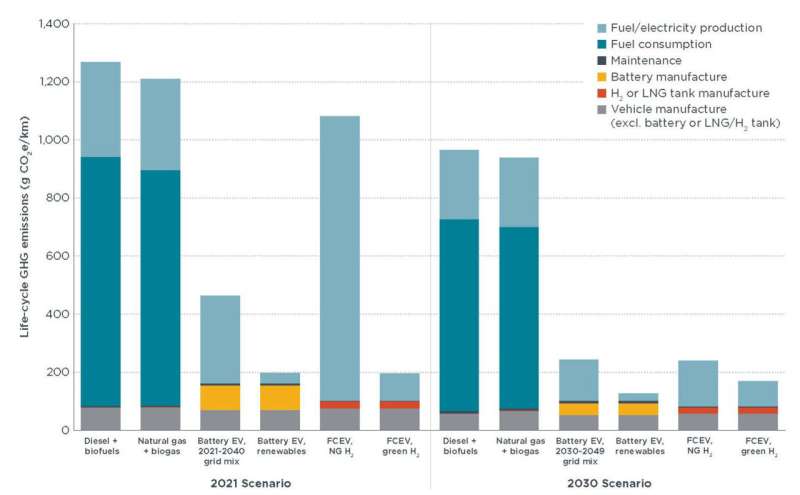This article has been reviewed according to Science X's editorial process and policies. Editors have highlighted the following attributes while ensuring the content's credibility:
fact-checked
proofread
Battery electric trucks emit 63% less GHG emissions than diesel, finds analysis

A new study compares the life-cycle greenhouse gas (GHG) emissions of electric, hydrogen, natural gas and diesel trucks and buses in Europe. The results indicate a clear pathway to decarbonize the sector: Battery electric models can deliver the greatest emission reductions even when using the EU's average electricity grid mix, which is not fully renewable but will continue to improve during the lifetime of the vehicles.
To reach the Paris Agreement goal of keeping global warming below 2 degrees Celsius, Europe needs to urgently decarbonize its trucks and buses, the highest emitting vehicles on the road. They represent only 2% of vehicles on the road but contribute to a quarter of transport-related emissions. The study, carried out by the non-profit research organization International Council on Clean Transportation (ICCT), offers a comprehensive picture of the life-cycle emissions of different powertrains and fuel options of these vehicles on a fully harmonized basis.
Its methodology addresses not only CO2 emissions resulting from vehicle tailpipes but also the GHG emissions arising from the manufacturing of the vehicles and their components, vehicle maintenance, fuel production, and electricity production. The study factors in the changes in the average electricity and fuel mix during the lifetime of today's vehicles.
A key finding of the study is that the greatest climate impact produced by trucks and buses over their whole life comes from the use or fuel consumption phase, not from the extraction of raw materials, construction, or maintenance.
"The problem is not the factory but the road. The high greenhouse gas intensity of driving a truck during its whole life offsets the GHG emissions generated during manufacturing or the production of the fuel, or the energy it consumes. Our study addresses the uncertainties surrounding the share of emissions in all stages of the vehicle's life. It shows that only battery electric and some fuel cell electric trucks can meet the climate targets in the sector," says Nikita Pavlenko, ICCT's Fuels Program Lead.
The comparison of the different powertrains and fuel options reveals that battery electric trucks take the lead in reducing GHG emissions. When estimated over the whole lifetime of a battery-electric 40-ton tractor-trailer entering service in 2021, these vehicle models produce at least 63% lower emissions compared to diesel. As the grid continues to decarbonize, the emissions of these will fall—the study shows an 84% reduction of emissions when using only renewable electricity.
Fuel cell electric trucks using hydrogen produced from fossil fuel produce 15% less GHG emissions compared to their diesel counterparts. The emissions reduction depends heavily on the source of hydrogen. With hydrogen produced with only renewable electricity, emissions fall by 85%. The GHG emission savings from hydrogen trucks are less than can be achieved from a battery electric model when using a non-renewable energy source.
"Increasing energy efficiency is the game-changing factor in shrinking the carbon footprint of battery electric trucks compared to the rest of the technologies. These models become the cleanest option even if the source of electricity is not fully clean. This is not the case for hydrogen trucks, which can become a promising option in the future if hydrogen is produced from a 100% renewable energy source. Today, their capacity to reduce emissions is still limited," says Felipe Rodríguez, ICCT's Program Lead.
In the various scenarios, natural gas trucks and buses provide, at best, marginal GHG emission reductions compared to diesel. We find that 2021 vehicle models have life-cycle emissions ranging from 4% to 18% lower than their diesel counterparts. Methane, which is a potent GHG that leaks from the vehicle and throughout the production and supply of natural gas, is a significant driver of the powertrain's emissions. However, the benefits from natural gas vehicles disappear when looking at short-term warming impacts, which result in 0% to 21% greater GHG emissions than diesel vehicles over natural gas trucks' full lifecycle.
"The climate benefits of natural gas urban buses compared to diesel are marginal at best when compared to diesel. Methane leakage may undermine the benefits of transitioning bus fleets to natural gas. Cities should consider their transport policy strategies with these numbers at hand," says Mr. Pavlenko.
The analysis evaluates the current best-in-class diesel models against their natural gas and zero-emission alternatives in the European market. Its methodology provides innovative contributions that distinguish it from other life-cycle analyses. The authors estimate present and projected future GHG emissions of trucks and buses and factor in the life-cycle average carbon intensity of fuel and electricity mixes, as well as changes in the fuel mix over the vehicle's lifetime considering present energy policies.
More information: White Paper: theicct.org/publication/lca-gh … -fuels-europe-feb23/


















